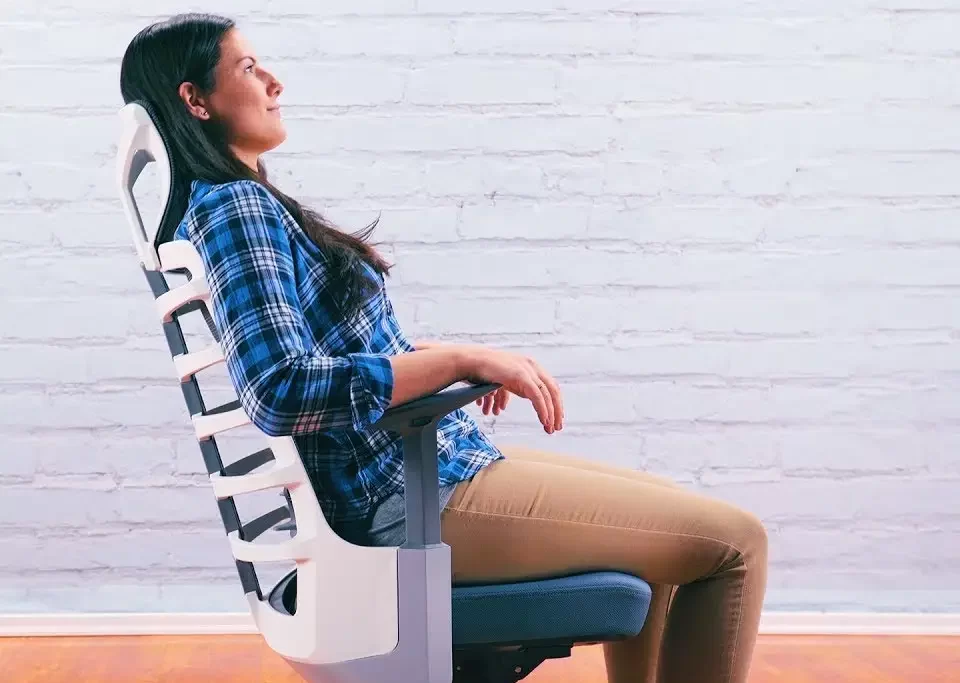This post contains affiliate links.
Have you ever spent hours at your desk, only to stand up and be greeted by an aching back? That’s where an office chair with lumbar support comes in. Lumbar support is designed to snugly fit your lower back and maintain the natural curve of your spine, which can help to prevent pain and fatigue.
In this blog post, we’ll discuss the 11 key features to look for in an office chair with lumbar support, so you can find the perfect fit for your needs.
1. Material Quality

The choice of material in an office chair significantly influences both comfort and functionality. A well-selected material ensures not just immediate comfort but also long-term support and durability.
Common Materials
- Mesh: Mesh is known for its breathability, making it an excellent choice for warmer climates or for individuals who prefer a cooler seating experience. This material often provides a subtle bounce, enhancing comfort without sacrificing support.
- Leather: Leather chairs are synonymous with luxury and style. They offer a comfortable seating experience, though they tend to retain more heat compared to other materials. Leather is often chosen for its aesthetic appeal and its ability to complement a professional environment.
- Fabric: Fabric chairs offer a wide range of textures and styles, allowing for personalization and aesthetic versatility. While fabric chairs are comfortable, they are more prone to staining and may require more maintenance.
So, which one suits you? If you tend to get warm, go for mesh. It’s breathable and keeps you cool. If you’re looking for a touch of luxury, leather is the way to go. If you want something that’s comfortable and comes in various styles, fabric is a solid choice. So, pick the one that fits your needs and comfort.
2. Adjustable Lumbar Support

The concept of “one size fits all” is notably inadequate when it comes to office chairs, particularly concerning lumbar support. The diversity in human spinal structure necessitates a more personalized approach to back support in seating.
Importance of Adjustable Lumbar Support
- Personalization: Every individual’s back has a unique curvature, and adjustable lumbar support allows each user to customize the chair to their specific spinal shape. This customization is crucial for providing proper support where it’s needed most.
- Enhanced Posture: Proper lumbar support promotes a better sitting posture. By adjusting to the natural curve of the spine, these chairs help maintain an ergonomically correct position, reducing the likelihood of slouching and the associated discomfort.
- Reduced Strain: Without adequate support, the lumbar region of the spine can be subjected to undue strain, leading to discomfort or even chronic back problems. Adjustable lumbar support mitigates this risk by providing targeted support, reducing pressure on the lower back.
- Versatility: Chairs with adjustable lumbar support cater to a wide range of body types and preferences, making them suitable for diverse office environments. This versatility ensures that each individual can find the right level of support, regardless of their body shape or size.
Understanding the critical role of adjustable lumbar support in maintaining a healthy back is essential. Learn more about how your office chair can impact your posture in my detailed guide.
3. Seat Depth
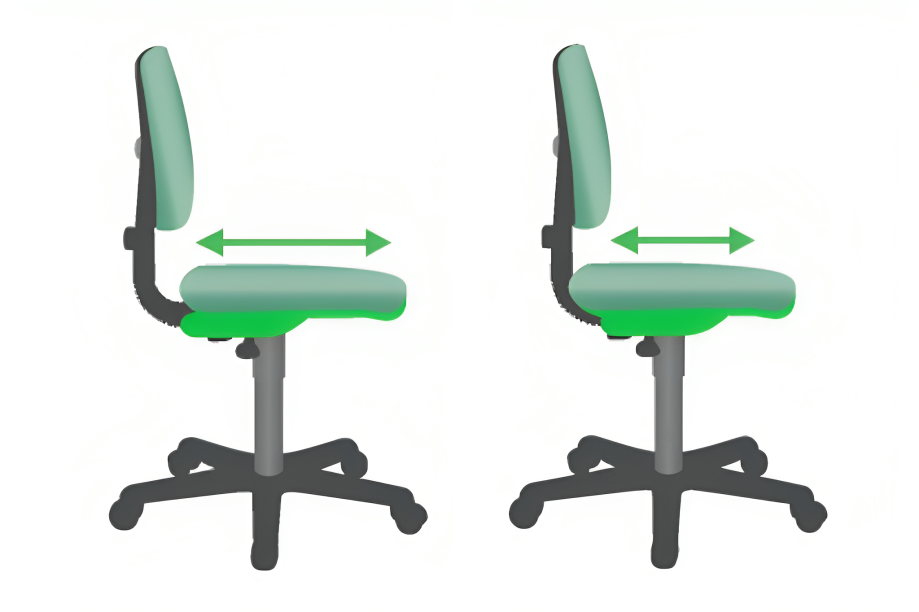
The significance of seat depth in office chairs is often underestimated, yet it plays a pivotal role in ensuring ergonomic comfort and maintaining proper posture. Appropriate seat depth is essential for aligning the body correctly with the chair’s backrest and lumbar support.
Impact of Seat Depth on Posture
- Too Deep Seats: When a seat is excessively deep, users may find themselves sitting at the edge, leading to improper posture and increased strain on the lumbar region. This position often results in slouching, a common contributor to back discomfort.
- Too Shallow Seats: Conversely, a seat that is too shallow fails to provide adequate thigh support, compromising the user’s ability to utilize the full benefits of the chair’s backrest and lumbar support.
Recommended Seat Depth for Different Body Types
- Shorter Individuals: For those of shorter stature, a seat depth ranging from 16 to 18 inches is typically suitable. This range ensures that the feet can comfortably rest flat on the floor while allowing the back to align properly with the lumbar support.
- Average Height Individuals: People of average height generally find a seat depth of 18 to 20 inches comfortable. This dimension provides balanced support for the thighs while ensuring that the backrest is effectively utilized.
- Taller Individuals: Taller users often require a seat depth of 20 to 22 inches for optimal comfort. This measurement provides adequate thigh support without causing the individual to sit too far forward.
4. Armrests
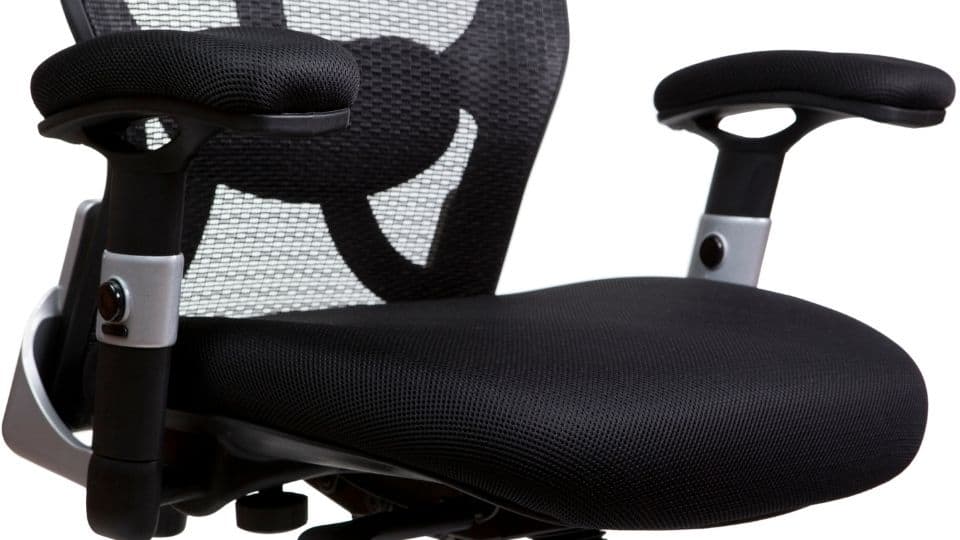
Proper arm support on a chair can greatly lessen the tension in your shoulders. This, in turn, helps to ease pressure on your back, leading to a more comfortable and healthier way of sitting.
Types of Armrests
- Fixed Armrests: These armrests are stationary and do not offer adjustability.
- Pros: Fixed armrests are generally more durable due to their solid construction. They are often more affordable, making them a practical choice for budget-conscious buyers.
- Cons: The lack of adjustability can lead to discomfort, especially for users whose body dimensions do not align with the fixed specifications. This inflexibility can result in improper arm positioning, which can negatively impact posture and comfort.
- Adjustable Armrests: These armrests allow adjustments in height, width, and sometimes even angle.
- Pros: The adjustability offers a high degree of customization, catering to individual needs and body types. This flexibility enhances ergonomics by allowing users to position their arms in the most comfortable and supportive manner.
- Cons: Chairs with adjustable armrests are typically more expensive, reflecting the added complexity and functionality of their design.
So, if you’re someone who values customization and comfort, adjustable armrests are your go-to. If you are on a budget, Fixed armrests aren’t a bad choice, though they may compromise on comfort and personal fit.
5. Swivel and Mobility
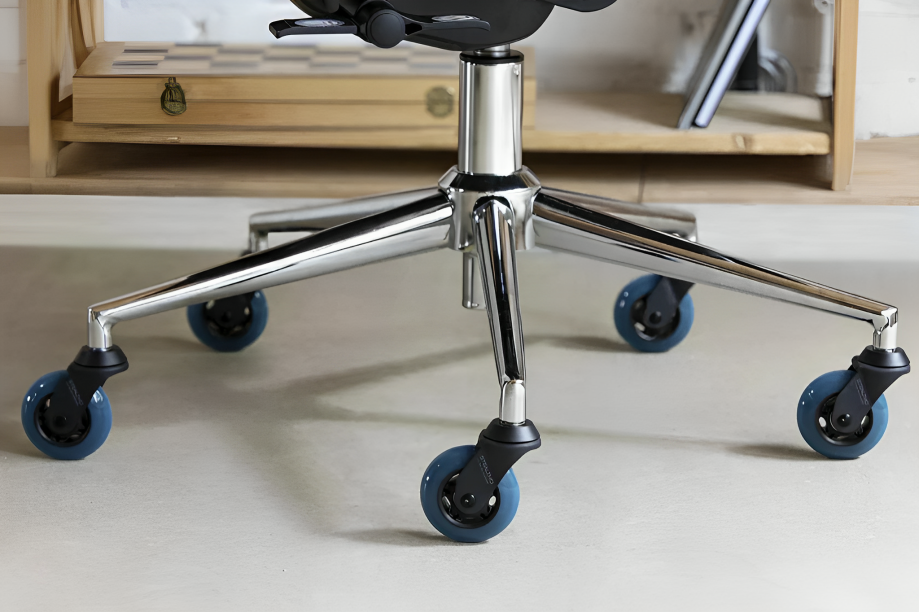
The swivel and mobility features of an office chair play a crucial role in facilitating movement and preventing strain. Chairs designed for easy movement enable users to reach different areas of their workspace without awkward twisting or stretching, which can be detrimental to back health.
Importance of Swivel and Mobility
- Reduced Strain: Chairs that swivel and glide smoothly minimize the need for excessive reaching or twisting. This reduces the risk of straining the back, which is common when using stationary chairs.
- Increased Efficiency: Mobile chairs enhance the ability to move around the workspace efficiently, allowing for easier access to different areas of the desk or surrounding space.
Types of Casters for Different Floor Types
- Hardwood Casters: These are typically designed for use on carpeted floors. They are generally harder and have less grip, which allows them to roll smoothly on the softer surface of a carpet without getting stuck.
- Soft Rubber Casters: Ideal for hardwood floors, these casters are made of softer materials that provide better traction and prevent sliding. They also help protect the floor from scratches and marks.
Choose the wrong type of wheels for your chair, and you might find yourself either stuck and unable to move easily, or sliding around too much, almost like you’re on an ice skating rink.
6. Weight Capacity

Chairs are engineered to provide optimal support and comfort within a specific weight range. Exceeding this limit can compromise the chair’s structural integrity and ergonomic features.
Impact of Exceeding Weight Capacity
- Lumbar Support Misalignment: When a chair holds more weight than it’s made for, its lower back support can move out of the right spot. This shift can cause you to sit in a less comfortable and healthy way.
- Compromised Posture and Comfort: An overloaded chair often fails to provide the necessary support, resulting in poor posture. The user may experience increased discomfort and a higher risk of back pain.
- Safety Concerns: Overloading a chair beyond its weight capacity can also pose a safety risk. The increased stress on the chair’s components can lead to mechanical failures, potentially causing injury.
Adhering to the specified weight capacity is not only a matter of comfort but also of safety. Manufacturers determine these limits based on rigorous testing to ensure the chair provides adequate support and maintains its structural integrity throughout its use.
7. Recline Function
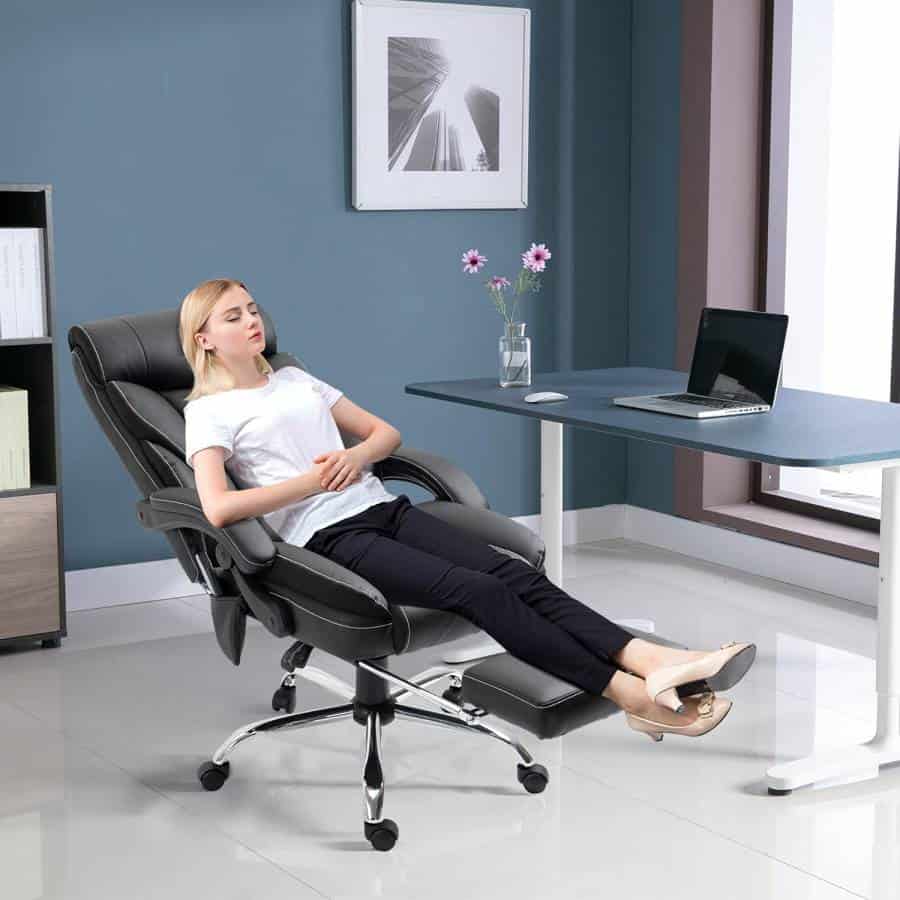
The recline function in office chairs is not merely a feature for relaxation but serves an important ergonomic purpose. It allows for the redistribution of the user’s body weight, which can significantly alleviate pressure on the lower back.
Optimal Recline Range
A recline angle ranging from 90 to 120 degrees is generally recognized as beneficial for back health. This range allows for a balanced distribution of body weight, reducing the load on the lower back.
Impact of Recline Angle on Back Health
- Angles Less Than 90 Degrees: Reclining at an angle less than 90 degrees can increase the strain on the back. This position may force the spine into an unnatural alignment, leading to discomfort or pain.
- Angles Greater Than 120 Degrees: On the other hand, reclining at an angle greater than 120 degrees might also be detrimental. In such a position, the back may not receive adequate support, particularly in the lumbar region, which can strain the muscles and ligaments.
The ability to adjust the recline angle allows users to find the most comfortable and supportive position for their specific body type and preferences. This adjustability is crucial in preventing back strain and maintaining an ergonomic posture, especially during prolonged periods of sitting.
8. Seat Height
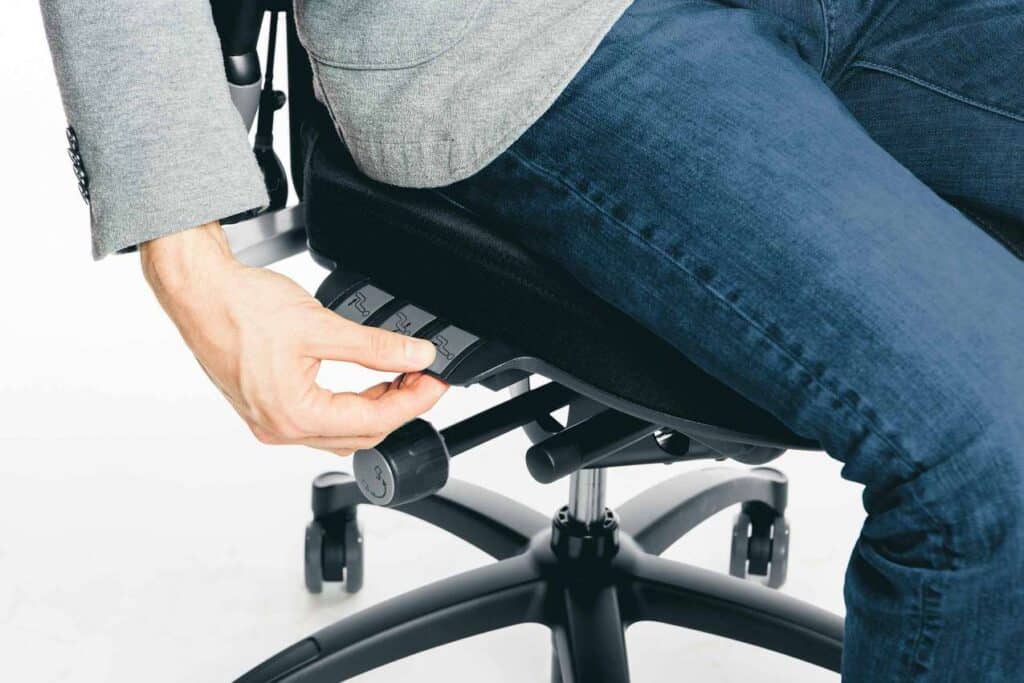
The seat height of an office chair is a fundamental aspect that significantly affects back comfort and overall posture. An improperly adjusted seat height can lead to discomfort and strain in the back, as it influences how the back interacts with the chair’s adjustable features.
Determining the Ideal Seat Height
- Proper Positioning: The ideal seat height is one where the user’s feet rest flat on the floor while maintaining a 90-degree angle at the knees. This position ensures that the thighs are parallel to the floor, promoting a balanced and ergonomic posture.
- Standard Height Range: Most office chairs offer a seat height adjustment range between 16 and 21 inches from the ground. This range accommodates a wide spectrum of user heights, ensuring that most individuals can achieve the correct seating position.
Impact of Seat Height on Ergonomics
- Feet Dangling: If the seat is too high, resulting in the feet dangling, it can lead to increased pressure under the thighs and reduced support for the lower back. This position can strain the lumbar region and disrupt the natural curve of the spine.
- Low Seating: Conversely, if the seat is too low, resembling a squatting position, it can place undue stress on the lower back and knees. This position often leads to a forward tilt of the pelvis, which can contribute to poor posture and back discomfort.
Chairs with a range of height adjustability offer the flexibility needed to cater to different body heights, making it an essential feature for anyone seeking a back-friendly office chair.
9. Warranty and Customer Support

The warranty and customer support associated with an office chair are important factors to consider, acting as a safeguard for your investment.
Importance of a Warranty
- Investment Protection: A warranty serves as a form of insurance for the buyer, offering protection against defects and malfunctions. It ensures that the chair will be repaired or replaced if it fails to meet the expected standards of quality and functionality.
- Reflects Quality: A good warranty often reflects the manufacturer’s confidence in the product’s durability. It assures buyers that the chair is built to last and is a reliable choice for long-term use.
Key Aspects of Customer Service
- Hassle-Free Returns: Essential for peace of mind, especially for online purchases. Easy returns without complicated processes are a plus.
- Responsive Service: Prompt and effective customer support is crucial for a positive experience and resolving any post-purchase issues.
- Setup and Troubleshooting Support: Assistance with assembly and addressing problems enhances user experience and ensures optimal use of the chair.
10. Price vs. Value

Evaluating the value for money when purchasing an office chair involves more than just considering the price. It’s about understanding the long-term benefits and features that contribute to comfort, posture, and productivity.
How to Assess Value for Money
- Longevity:
- Importance: The durability of a chair is a key factor. A chair that lasts several years is more cost-effective than one needing frequent replacements.
- Assessment: Look for chairs made with high-quality materials and robust construction, as these are more likely to endure regular use over time.
- Features:
- Importance: The range and quality of features in a chair determine its adaptability to individual needs.
- Assessment: Chairs offering adjustable armrests, seat depth, and lumbar support provide a higher level of customization. More adjustable features often equate to a better ergonomic experience.
- Comfort:
- Importance: Comfort is crucial, especially for those spending long hours seated.
- Assessment: A chair that allows you to sit for extended periods without discomfort is indicative of good value. This can be gauged by testing the chair or reading user reviews.
Don’t just look at the price; look at what the chair brings to your life. Is it comfort? Is it better posture? Weigh these against the cost to make an informed decision.
11. User Reviews and Ratings

You wouldn’t buy a car without reading reviews. The same goes for your office chair. They provide insights into the real-world performance and suitability of a chair, acting as indicators of what to expect.
Importance of Reviews
- Insight into User Experience: Reviews offer a firsthand account of a chair’s comfort, durability, and functionality from various users.
- Body Size Diversity: Reviews from users of different body sizes can help gauge whether a chair is likely to be a good fit for a wide range of individuals.
Red Flags to Watch Out For
- Consistent Complaints: Repeated negative feedback on specific issues, such as durability problems or inadequate support, can indicate underlying flaws in the chair.
- Too Good to Be True: Be wary of reviews that sound too good to be true, especially if they lack detailed information or seem more like marketing than genuine feedback.
So, before you hit that “Buy Now” button, spend some time scrolling through the reviews. It’s like doing your homework before a big test, and trust me, your back will thank you for it.
Before you go…
Remember that your choice is more than just about comfort; it’s about enhancing your overall work experience. To further enrich your understanding, I highly recommend my previous article.

